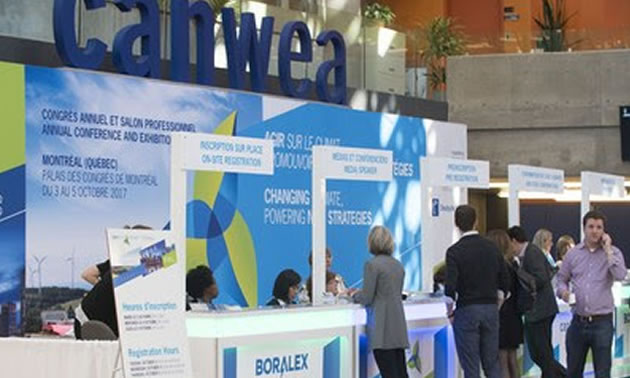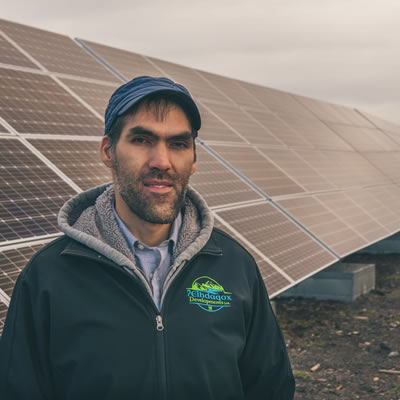Wind energy a key to energy transition

The CanWEA 2017 Conference and Exhibition was held from October 3-5 in Montreal, Quebec. — Photo courtesy Canadian Wind Energy Association
MONTREAL, Oct. 3, 2017 /CNW/ - Increased utilization of Canada's massive untapped reserves of low-cost wind energy will be critical if this country is to remain competitive in the global shift to a low-carbon economy, industry leaders agreed at the recent Canadian Wind Energy Association's (CanWEA) 33rd Annual Conference and Exhibition.
More than 1,200 wind energy professionals from Canada and around the world attended CanWEA 2017, held October 3-5 at the Palais des congrès de Montréal. Hosted by CanWEA and Hannover Fairs (Canada), the 2 ½-day event featured a dynamic line-up of expert speakers on a range of topics that included emerging business development opportunities, wind and energy market trends, industry best practices and technology innovation. More than 110 exhibitors, representing the industry's leading companies in Canada, showcased the latest in wind-related products and services on the tradeshow floor.
Keynote speakers included Kim Rudd, Parliamentary Secretary to Canada's Minister of Natural Resources, The Honourable Jim Carr, and The Honourable Sergio Marchi, CEO of the Canadian Electricity Association.
The electricity grid of the future was in the spotlight during the conference's opening plenary session. Independent experts and electricity sector professionals weighed in on how cost-competitive renewable generation sources, rapidly advancing smart grid and storage technologies, shifting consumer expectations, and a global commitment to clean growth are transforming the way we produce and use energy. Panellists also shared insights on how governments and utilities in Canada can lead this transition, noting that Quebec's 2030 Energy Policy links the province's renewable resources to its future economic prosperity. At the same time Alberta and Saskatchewan are moving aggressively to modernize their electricity grids and revitalize their economies by targeting clean energy development and Ontario is about to release its Long-Term Energy Plan (LTEP) that will have to support its efforts to reduce greenhouse gas emissions 80 per cent by 2050.
Additional plenary sessions delved into emerging demand drivers for wind, including the rise of electric vehicles, new opportunities in remote communities and northern Canada, the increasing interest in wind energy exports to the United States, and the upsurge in corporate renewable energy purchases. The conference's closing plenary focused on the electricity market reforms needed to help drive investment to cleaner sources of generation.
The program also featured eight concurrent educational sessions, providing insight on how forward-thinking wind farm operators, project developers and electricity system planners can turn change into opportunity, tackling the permitting, resource assessment, and health and safety challenges facing a growing industry, and delving into the operational improvements and technology advancements that will contribute to the sector's long-term success.
Quotes
"It's becoming more obvious every day that we are on a path to a clean energy future, and that wind energy, as the lowest-cost source of new emissions-free electricity, must play a pivotal role in getting us there. That's why we chose Energy Transition as the theme for this year's CanWEA conference. As the energy landscape continues to evolve, it will not only open new markets for our industry, but create new opportunities for Canada to capitalize on its abundant and diverse renewable energy resources."
- Robert Hornung, president, Canadian Wind Energy Association (CanWEA)
"Quebec was one of the first provinces to adopt wind energy on a large-scale, and by working to develop new markets for its clean energy resources through its export and electrification initiatives, it is once again carving out a leadership role. We're excited to be in Montreal to talk about what's next for our industry as the shift to a more sustainable future takes hold."
- Cory Basil, vice-president of development for EDF EN Canada and Board Chair for the Canadian Wind Energy Association (CanWEA)
Background
- Canada currently has over 12,000 MW of wind energy, the eighth largest wind generating fleet in the world. More wind energy has been built in Canada over the last decade than any other form of electricity generation, with installed capacity growing by an average of 18 per cent a year over the past five years. To learn more, please visit the Wind Markets section of CanWEA's website.
- Bloomberg New Energy Finance's New Energy Outlook 2017 predicts that nearly three-quarters of the US$10.2 trillion to be spent on new power generation worldwide to 2040 will be invested in wind and solar plants. Wind and solar will make up 48 per cent of the world's installed generating capacity and 34 per cent of electricity generation by 2040, compared with just 12 per cent and five per cent now.
- Renewable energy will make up nearly half of global energy supply by 2050, says independent advisory firm DNV GL in its inaugural Energy Transition Outlook.
- CanWEA's ground-breaking Pan-Canadian Wind Integration Study demonstrates that provinces across Canada can reliably integrate the large amounts of renewable energy required to meet their environmental and economic goals.
- A new Léger public opinion poll in Quebec (available in French only) demonstrates that people in Quebec are strongly supportive of wind technology and are in favour of continuing to deploy wind energy to achieve the objectives of the energy transition.
- A new Alberta Supply Chain Study finds that the Alberta government's Renewable Energy Plan will drive $8.3 billion of investment in new wind energy projects in the province. These projects are expected to result in $3.7 billion in local spending and 15,000 job years of employment by 2030.
- With wind energy poised to play a growing role in Canada's electricity system, developing a strong and diverse workforce is essential. With that in mind, CanWEA has recently become an Advocate for The Leadership Accord on Gender Diversity in the Canadian Electricity Industry, an initiative of Electricity Human Resources Canada.
About the Canadian Wind Energy Association
CanWEA is the voice of Canada's wind energy industry, actively promoting the responsible and sustainable growth of wind energy. A national non-profit association, CanWEA serves as Canada's leading source of credible information about wind energy and its social, economic and environmental benefits. Join us on Facebook, follow us on Twitter and LinkedIn. Learn more at www.canwea.ca.




